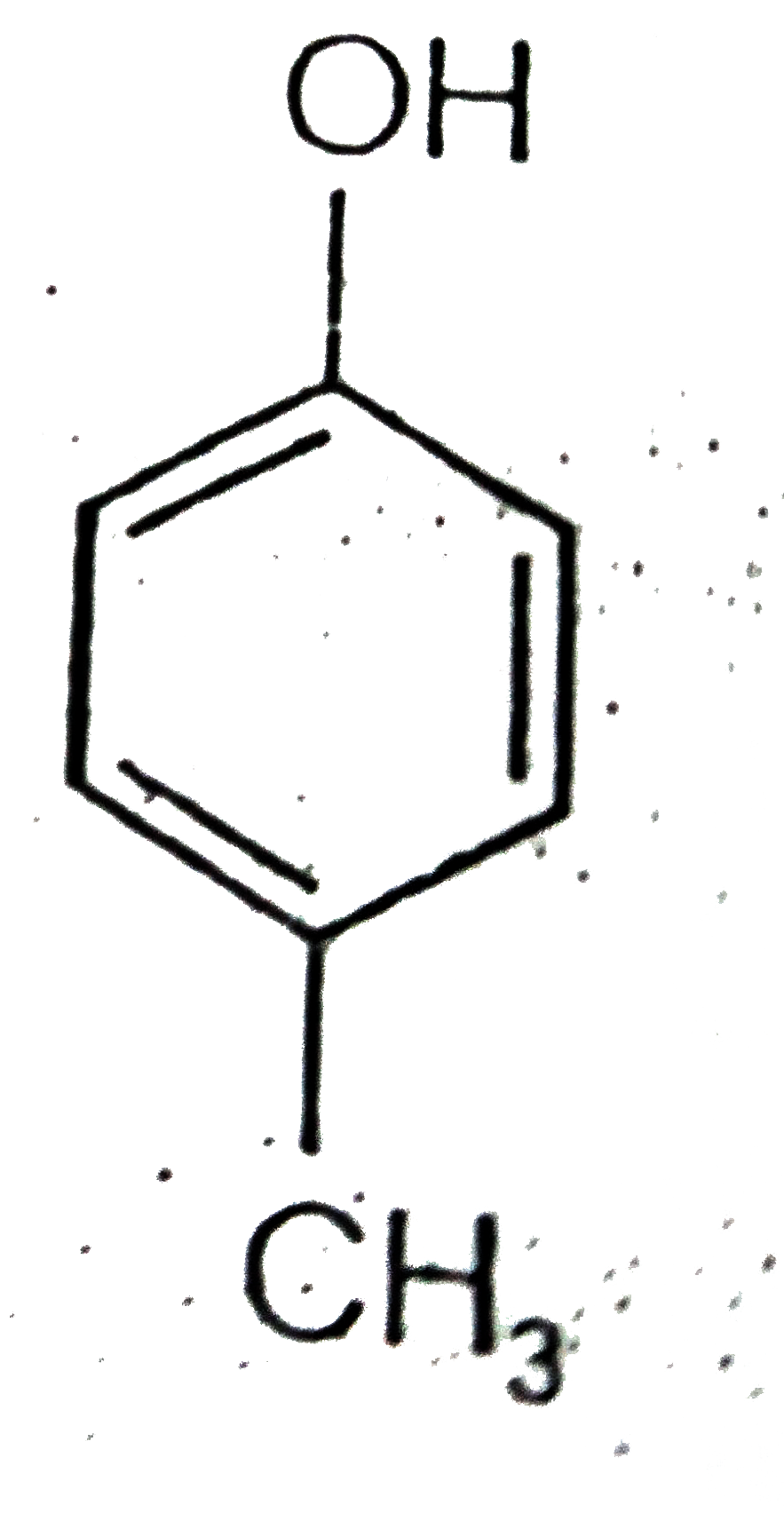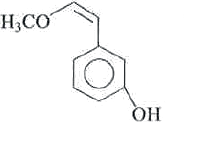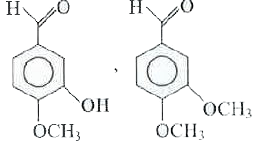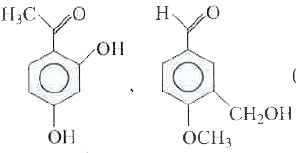Compound (X ) C7H8O dissolves in NaOH but not in NaHCO3 ( X) reacts rapidly with Br2 to give (Y) C7H5OBr3 Product structure of X would be




The correct Answer is:B
To determine the structure of compound (X) with the molecular formula C₇H₈O, we will follow these steps:
Step 1: Analyze the given information
- The compound (X) has the molecular formula C₇H₈O.
- It dissolves in NaOH but not in NaHCO₃.
- It reacts rapidly with Br₂ to give a product (Y) with the formula C₇H₅OBr₃.
Step 2: Determine the functional group
Since (X) dissolves in NaOH, it indicates that (X) is likely an alcohol or a phenol. The fact that it does not dissolve in NaHCO₃ suggests that it is not a carboxylic acid, as carboxylic acids typically react with NaHCO₃.
Step 3: Consider possible structures
Given the molecular formula C₇H₈O, we can consider various isomers:
- Benzyl alcohol (C₆H₅CH₂OH)
- Cresols (ortho, meta, para)
- Other possible phenolic compounds.
Step 4: Analyze the reaction with Br₂
The rapid reaction with Br₂ suggests that (X) contains an aromatic ring, as alkenes and phenols typically react with bromine. The product (Y) has the formula C₇H₅OBr₃, indicating that three bromine atoms are added to the structure of (X).
Step 5: Identify the structure of (X)
Considering the information, we can deduce that:
- If (X) is a cresol, it would react with Br₂ to yield a brominated product.
- The structure of (X) could be meta-cresol (C₆H₄(CH₃)OH), which would react with Br₂ to give the product with three bromine atoms.
Conclusion
The structure of compound (X) is likely meta-cresol (C₆H₄(CH₃)OH), which matches the criteria provided in the question.
- The compound (X) has the molecular formula C₇H₈O.
- It dissolves in NaOH but not in NaHCO₃.
- It reacts rapidly with Br₂ to give a product (Y) with the formula C₇H₅OBr₃.
Since (X) dissolves in NaOH, it indicates that (X) is likely an alcohol or a phenol. The fact that it does not dissolve in NaHCO₃ suggests that it is not a carboxylic acid, as carboxylic acids typically react with NaHCO₃.
Given the molecular formula C₇H₈O, we can consider various isomers:
- Benzyl alcohol (C₆H₅CH₂OH)
- Cresols (ortho, meta, para)
- Other possible phenolic compounds.
The rapid reaction with Br₂ suggests that (X) contains an aromatic ring, as alkenes and phenols typically react with bromine. The product (Y) has the formula C₇H₅OBr₃, indicating that three bromine atoms are added to the structure of (X).
Considering the information, we can deduce that:
- If (X) is a cresol, it would react with Br₂ to yield a brominated product.
- The structure of (X) could be meta-cresol (C₆H₄(CH₃)OH), which would react with Br₂ to give the product with three bromine atoms.
The structure of compound (X) is likely meta-cresol (C₆H₄(CH₃)OH), which matches the criteria provided in the question.
Similar Questions
An organic compound (A) with molecular formula C7H8O dissolves in NaOH and gives characteristic colour with FeCl3. On treatment with Br2, it gives a tribromo product C7H5OBr3. The compound is:
View SolutionAn organic compound (A) with molecular formula C7H8O dissolves in NaOH and gives characteristic colour with FeCl3. On treatement with Br3, it gives a tribromo product C7H5Br3. The compound is:
View Solution
Knowledge Check
Compound (A) C10H22O2 is insoluble in aq. NaOH but not in NaHCO3. Treatment of (A) with DMSO ⎛⎜ ⎜⎝CH3−O∣∣S−CH3⎞⎟ ⎟⎠ in alkali give (B) C11H14O2. Treatment of (A) with strong alkali alone give an isomeric compound ( C). When (A) is refluxed with HI, CH3I is obtained, compound (B) is insoluble in alkali and decolourises Br2/CCl4. (B) on treating with strong base gives (D), an isomer of (B). Ozonolysis ( C) of gives (E), C8H8O3 and isomer of vanilline. Ozonolysis of (D) gives (F) C9H10O3, which is identical with product of methylation of vanilline (4-hydroxy-3-methoxy benzaldehyde).
Structure of compound (A) is :A B
B C
C D
D
Compound (A) C10H22O2 is insoluble in aq. NaOH but not in NaHCO3. Treatment of (A) with DMSO ⎛⎜ ⎜⎝CH3−O∣∣S−CH3⎞⎟ ⎟⎠ in alkali give (B) C11H14O2. Treatment of (A) with strong alkali alone give an isomeric compound ( C). When (A) is refluxed with HI, CH3I is obtained, compound (B) is insoluble in alkali and decolourises Br2/CCl4. (B) on treating with strong base gives (D), an isomer of (B). Ozonolysis ( C) of gives (E), C8H8O3 and isomer of vanilline. Ozonolysis of (D) gives (F) C9H10O3, which is identical with product of methylation of vanilline (4-hydroxy-3-methoxy benzaldehyde).
Compound (B) is :A B
B C
C D
D
Compound (A) C10H22O2 is insoluble in aq. NaOH but not in NaHCO3. Treatment of (A) with DMSO ⎛⎜ ⎜⎝CH3−O∣∣S−CH3⎞⎟ ⎟⎠ in alkali give (B) C11H14O2. Treatment of (A) with strong alkali alone give an isomeric compound ( C). When (A) is refluxed with HI, CH3I is obtained, compound (B) is insoluble in alkali and decolourises Br2/CCl4. (B) on treating with strong base gives (D), an isomer of (B). Ozonolysis ( C) of gives (E), C8H8O3 and isomer of vanilline. Ozonolysis of (D) gives (F) C9H10O3, which is identical with product of methylation of vanilline (4-hydroxy-3-methoxy benzaldehyde).
A B
B C
C DNone of these
DNone of these
Compound A (C7H8O) is insoluble in water, dilute HCl & aqueous NaHCO3, but it dissolves in dilute NaOH. When A is treated with Br2 water it is converted into a compound C7H5Obr3 rapidly. The structure of A is:
View SolutionCompound (A)C7H8O is insoluble in aqueous NaHCO3 and dissolves in aqueous NaOH and gives a characteristic colour with neutral FeCl3 . When treated with Br2(A) forms compound (B)C7H5OBr3.
The most probable structure of compound A is :
View SolutionCompound 'P', C7H8O is insoluble in water, dilute HCl and NaHCO3 . It dissolves in dilute NaOH . When P is treated with Br2−H2O , it converts rapidly into a compound of formula C7H5OBr3 . Identify structure of :
View SolutionCompound (A) C7H8O is insoluble in aqueous NaHCO3 and dissolves in aqueous NaOH and gives a characteristic colour with neutral FeCl3 . When treated with Br2 (A) forms compound (B) C7H5OBr3 .
The structure of compound (B) would be :
View SolutionA compound 'A' (C7H8O) is insoluble in water, dilute Hcland aqueous NaHCO3 but soluble in dilute NaOH. When Ais treated with Br2−H2O, it is converted into a compound of formula C7H5Obr3. Compound A is :
View Solution
